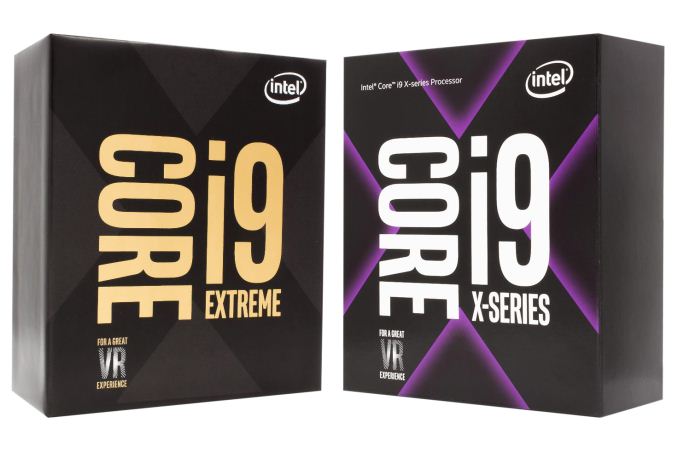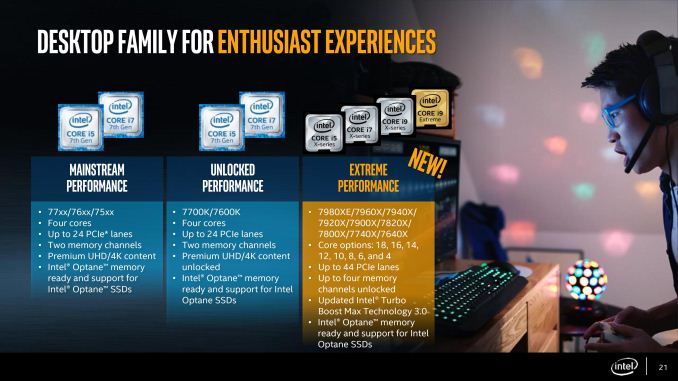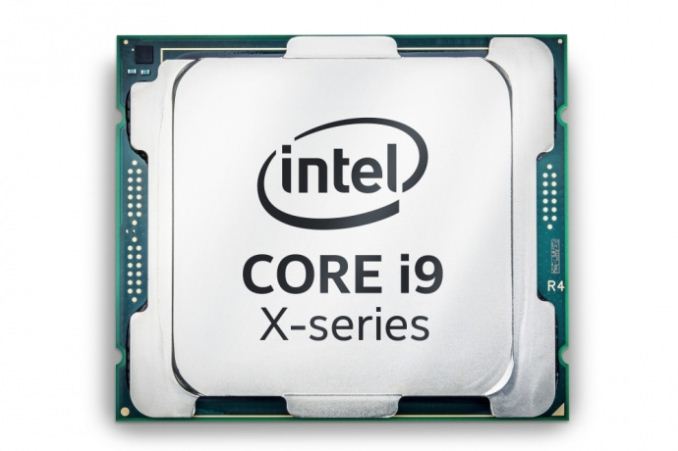Intel Announces Skylake-X: Bringing 18-Core HCC Silicon to Consumers for $1999
by Ian Cutress on May 30, 2017 3:03 AM EST
There are days in this profession in which I am surprised. The longer I stay in the technology industry, they become further and further apart. There are several reasons to be surprised: someone comes out of the blue with a revolutionary product and the ecosystem/infrastructure to back it up, or a company goes above and beyond a recent mediocre pace to take on the incumbents (with or without significant financial backing). One reason is confusion, as to why such a product would ever be thought of, and another is seeing how one company reacts to another.
We’ve been expecting the next high-end desktop version of Skylake for almost 18 months now, and fully expected it to be an iterative update over Broadwell-E: a couple more cores, a few more dollars, a new socket, and done. Intel has surprised us with at least two of the reasons above: Skylake-X will increase the core count of Intel’s HEDT platform from 10 to 18.
The Skylake-X announcement is a lot to unpack, and there are several elements to the equation. Let’s start with familiar territory: the first half of the processor launch.
Announcement One: Low Core Count Skylake-X Processors
The last generation, Broadwell-E, offered four processors: two six-core parts, an eight-core part, and a top-tier 10-core processor. The main difference between the two six-core parts was the PCIe lane count, and aside from the hike in pricing for the top-end SKU, these were iterative updates over Haswell-E: two more cores for the top processor.
This strategy from Intel is derived from what they call internally as their ‘LCC’ core, standing for ‘low core count’. The enterprise line from Intel has three designs for their silicon – a low core count, a high core count, and an extreme core count: LCC, HCC, and XCC respectively. All the processors in the enterprise line are typically made from these three silicon maps: a 10-core LCC silicon die, for example, can have two cores disabled to be an 8-core. Or a 22-core XCC die can have all but four cores disabled, but still retain access to all the L3 cache, to have an XCC processor that has a massive cache structure. For the consumer HEDT platform, such as Haswell-E and Broadwell-E, the processors made public were all derived from the LCC silicon.
The first half of the Skylake-X processor llineup follows this trend. Intel will launch four Skylake-X processors based on the LCC die, which for this platform will have a maximum of 12 cores. All processors will have hyperthreading.
| Skylake-X Processors (Low Core Count Chips) | ||||
| Core i7-7800X | Core i7-7820X | Core i9-7900X | Core i9-7920X | |
| Cores/ Threads |
6/12 | 8/16 | 10/20 | 12/24 |
| Base Clock | 3.5 GHz | 3.6 GHz | 3.3 GHz | TBD |
| Turbo Clock | 4.0 GHz | 4.3 GHz | 4.3 GHz | TBD |
| TurboMax Clock | N/A | 4.5 GHz | 4.5 GHz | TBD |
| L3 | 8.25 MB | 11 MB | 13.75 MB | TBD (Likely 13.75 MB) |
| PCIe Lanes | 28 | 44 | TBD (Likely 44) |
|
| Memory Channels | 4 | |||
| Memory Freq | DDR4-2400 | DDR4-2666 | TBD | |
| TDP | 140W | TBD | ||
| Price | $389 | $599 | $999 | $1199 |
The bottom processor is the Core i7-7800X, running at 3.5 GHz with a 4.0 GHz turbo. This design will not feature Intel’s new ‘favored core’ Turbo 3.0 technology (more on that below), but will have six cores, support quad-channel memory at DDR4-2400, come in at a TDP of 140W, have 28 PCIe lanes, and retail for around $400. This processor will be the entry level model, for any user who needs the benefit of quad-channel memory but perhaps doesn’t need a two-digit number of cores or has a more limited budget.
Next up is the Core i7-7820X, which hits a potential sweet spot in the LCC design. This is an eight-core processor, with the highest LCC base clock of 3.6 GHz and the joint-highest turbo settings: 4.3 GHz for regular turbo and 4.5 GHz for favored core. Unlike the previous processor, this CPU gets support for DDR4-2666 memory.
However in another break from Intel’s regular strategy, this CPU will only support 28 PCIe lanes. Normally only the lowest CPU of the HEDT stack would be adjusted in this way, but Intel is using the PCIe lane allocation as another differentiator as a user considers which processor in the stack to go for. This CPU also runs in at 140W, and comes in at $600. At this price, we would expect it to be competing directly against AMD’s Ryzen 7 1800X, which will be the equivalent of a generation behind in IPC but $100 cheaper.
| Comparison: Core i7-7820X vs. Ryzen 7 1800X | ||
| Intel Core i7-7820X |
Features | AMD Ryzen 7 1800X |
| 8 / 16 | Cores/Threads | 8 / 16 |
| 3.6 / 4.3GHz (4.5 GHz TMax) |
Base/Turbo | 3.6 / 4.0 GHz |
| 28 | PCIe 3.0 Lanes | 16 |
| 11 MB | L3 Cache | 16 MB |
| 140 W | TDP | 95 W |
| $599 | Price (MSRP) | $499 |
The third processor is also a change for Intel. Here is the first processor bearing the new Core i9 family. Previously we had Core i3, i5 and i7 for several generations. This time out, Intel deems it necessary to add another layer of differentiation in the naming, so the Core i9 naming scheme was the obvious choice. If we look at what the Core i9 name brings to the table, the obvious improvement is PCIe lanes: Core i7 processors will have 28 PCIe lanes, while Core i9 processors will have 44 PCIe lanes. This makes configuring an X299 motherboard a little difficult: see our piece on X299 to read up on why.
Right now the Core i9-7900X is the only Core i9 with any details: this is a ten core processor, running with a 3.3 GHz base, a 4.3 GHz turbo and a 4.5 GHz favored core. Like the last processor, it will support DDR4-2666 and has a TDP of 140W. At this level, Intel is now going to charge $100/core, so this 10-core part runs in at a $999 tray price ($1049 retail likely).
One brain cell to twitch when reading this specification is the price. For Ivy Bridge-E, the top SKU was $999 for six-cores. For Haswell-E, the top SKU was $999 for eight-cores. For Broadwell-E, we expected the top SKU for 10-cores to be $999, but Intel pushed the price up to $1721, due to the way the enterprise processors were priced. For Skylake-X, the new pricing scheme is somewhat scrapped again. This 10-core part is now $999, which is what we expected the Broadwell-E based Core i7-6950X to be. This isn’t the top SKU, but the pricing comes back down to reasonable levels.
Meanwhile for the initial launch of Skylake-X, it is worth noting that this 10-core CPU, the Core i9-7900X, will be the first one available to purch. More on that later.
Still covering the LCC core designs, the final processor in this stack is the Core i9-7920X. This processor will be coming out later in the year, likely during the summer, but it will be a 12-core processor on the same LGA2066 socket for $1199 (retail ~$1279), being part of the $100/core mantra. We are told that Intel is still validating the frequencies of this CPU to find a good balance of performance and power, although we understand that it might be 165W rather than 140W, as Intel’s pre-briefing explained that the whole X299 motherboard set should be ready to support 165W processors.
In the enterprise space, or at least in previous generations, Intel has always had that processor that consumed more power than the rest. This was usually called the ‘workstation’ processor, designed to be in a single or dual socket design but with a pumped up frequency and price to match. In order for Intel to provide this 12-core processor to customers, as the top end of the LCC silicon, it has to be performant, power efficient, and come in at reasonable yields. There’s a chance that not all the factors are in place yet, especially if they come out with a 12-core part that is clocked high and could potentially absorb some of their enterprise sales.
Given the expected timing and launch for this processor, as mentioned we were expecting mid-summer, that would have normally put the crosshairs into Intel’s annual IDF conference in mid-August, although that conference has now been canned. There are a few gaming events around that time to which Intel may decide to align the launch to.












203 Comments
View All Comments
ddriver - Tuesday, May 30, 2017 - link
You fail miserably at making a point. I am comparing the latest and greatest both companies had on the market at the time. Now back under the bridge with you!Ranger1065 - Wednesday, May 31, 2017 - link
ddriver, I always respect your perspective at Anandtech particularly when it differs from general opinion as, thankfully, it often does. I also admire the tenacity with which you stick to your guns. The comments section would certainly be an infinitely more boring and narrow minded place without you. Keep up your excellent posts.fanofanand - Wednesday, May 31, 2017 - link
+1He is the most entertaining person here, I love reading his take on things.
Ro_Ja - Thursday, June 1, 2017 - link
Your comment is the reason why I scroll down this section.Hxx - Tuesday, May 30, 2017 - link
I dont think you understand the meaning of the word desperate at least in this context. Maybe intel redesigned their release schedule in response to ryzen who the f knows except their upper mngmt and thats irrelevant, in the end what matters is what the consumer gets and for what PRICE. If intel was truly desperate that we would have at least seen a price cut in their current cpu lineup and Im not seein that. These CPUs are also targeted at the enthusiast crowd and nowhere near Ryzen's price point so wheres the desperation again?rarson - Wednesday, May 31, 2017 - link
The marketing alone, never mind the fact that Intel's cannibalizing their own sales selling HCC chips to consumers, reeks of desperation.DC Architect - Tuesday, May 30, 2017 - link
If you think CIO's give a damn about "brand loyalty" over profit margins then you are high. Also... 99.8% of the people using computers couldn't tell you what a motherboard IS or what components are in their "hard drive box" let alone have any loyalty to those brands. The guys making the call on these kinds of decisions could give a rats ass what the guy on the floor wants when he can increase the margins by 100% and only lose 1% in IPC.We're not talking about server CPU's here that are parsing huge databases 24/7. That 1-5% IPC loss for your Joe Shmoe user matters a lot less when you can tell the CEO that you only need half your normal operating budget this year for workstations.
Icehawk - Tuesday, May 30, 2017 - link
Brand loyalty is HUGE in the corporate/server marketplace, it's foolish to think otherwise. Most large companies lock in with one or two vendors and buy whatever they offer that closest fits their needs or are able to get custom orders if the volume is enough. Never in my 19 years in IT have I seen or used a single AMD server, and only in a very few (crappy) laptops. Even back in the Athlon days we would stick with Intel as they are a known quantity and well supported.Hell where I work now they buy i7s for their grunts when an i3 would be fine - but it is easier on accounting to just deal with one SKU and easier for IT as well to only deal with a single configuration. The hardware cost differential can be offset by factors such as these.
On non server side, I am really happy to see AMD doing better - I probably will go with the 7820 though as I do value single threaded a lot (gaming) and also do a ton of reencoding to x265 where more cores would really help.
theuglyman0war - Thursday, June 8, 2017 - link
to be fair... I assume all those TBD's certainly do represent an "upcoming" response to ryzen that we would not had seen to whatever degree the final form takes. And that is awesome.The healthy competitive market is officially TBD! :)
Anyone with any reason is waiting for the dust to settle and the market to correct itself with a consumer response the way healthy markets should function.
alpha754293 - Friday, June 2, 2017 - link
It's "funny" reading your comment only because so much of it is so wrong/unfounded on so many levels.I used to be a strictly AMD-only shop because they offered a much better economic efficiency (FLOP/$).
Now, pretty much all of my new systems are all Intel because Intel is now better in terms of FLOP/$. (And also in just pure, brute-force performance).
AMD really screwed the pooch when they went with the shared FPU between two ALU design in their MCMs rather than having a dedicated FPU PER ALU (something which the UltraSPARC Niagara T1 originally did, and then revised it with T2).
It was choking/strangling itself. WHYYY Derrick Meyer (being a former EE himself) would allow that is beyond me.
I pick it pretty much solely based on FLOP/$ (as long as the $ piece of it isn't SO high that I can't afford to pay for it/buy it).
There ARE some times when you might want or even NEED a super high powered, many, many many core count system because if you can do a lot of development work deskside, you refine your model piece by piece without having to spend a great deal of time re-running the whole thing always, everytime; and once your model is set up, THEN you ship it/send it off to the cluster and let the cluster go at it.
If you are doing your debugging work on the cluster, you're just taking valuable time from the cluster away. (Like when I am doing some of my simulation stuff, the volume of data that gets generated is in the TBs now, so having to send the data back and forth when you have "bad" data (say from a run that errored out) - you're literally just shovelling crap around, which takes time and doesn't do anything useful or productive.
re: your 70 active systems
On the assumption that they're ALL 3770K chips, that's about 280 cores. You can probably get yourself a bunch of these:
http://www.ebay.com/itm/2U-Supermicro-6027TR-HTRF-...
to replace your compute farm.
I would be willing to bet that between 2-4 of those can replace your entire farm and still give you better FLOP/$.